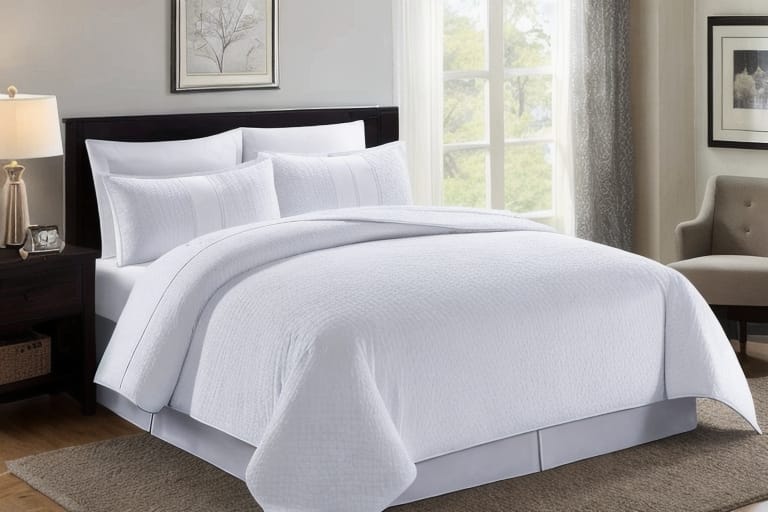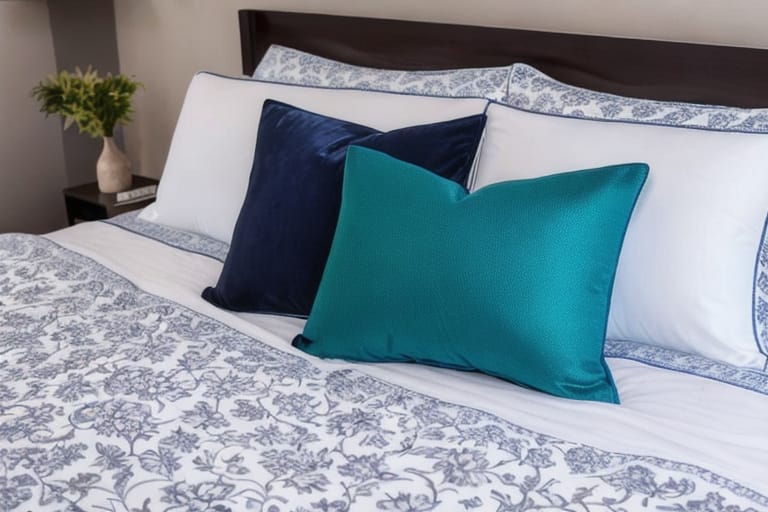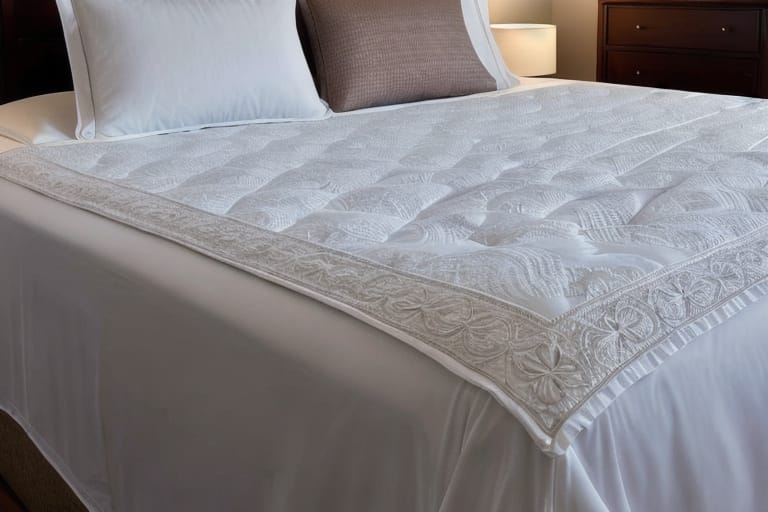When it comes to finding the perfect down comforter, there are so many factors to consider that it can feel downright overwhelming for first-time buyers. This definitive beginner’s guide covers everything you need to know—from understanding fill power and baffle box construction to warmth ratings and care instructions—to help you confidently choose the best down comforter to keep you cozy all year round.
A Crash Course on Down Comforters
Down comforters are fluffy, soft duvets filled with fine down feathers collected from ducks or geese. They trap air remarkably well, creating loft and plumpness that keeps you blissfully toasty without extra weight. When buying a down comforter, you’ll typically choose from these major types of down:
- Goose down: More expensive but also warmer and more durable per ounce
- Duck down: More affordable but still high quality in most cases
- Down alternatives: For allergy sufferers, these use synthetic microfibers instead of natural down
Unlike down alternative comforters filled with polyester and other synthetic fillings, real down comforters provide unrivaled softness and cloud-like comfort. The insulating properties of down feathers allow them to efficiently trap warm air and maintain it through small air pockets between feather filaments and clusters. This gives down outstanding warmth without weight.
When choosing the best down comforter, pay special attention to these key specifications:
- Fill power: The loft and quality of the down fill
- Construction: Baffle boxes that prevent fill shifting
- Shell material: Breathable cotton or other fabrics
- Size and warmth rating: Matches your bed and climate needs
With the right combo of features, a good down comforter can last over a decade. Now let’s explore those crucial factors in more detail!
The 6 Comforter Features To Compare
1. Fill Power
Fill power is the key indicator of down quality, measuring the loft and insulation. Fill power ranges from about 300 to 900+. Higher numbers mean more air trapped per ounce of material for increased warmth without weight.
As a rough guide:
- 300-400 fill power: Low quality
- 400-600 fill power: Decent warmth for the price
- 600-800+ fill power: Premium quality down
Ideally look for a minimum fill power of 600 for the best long-term comfort and value.
2. Baffle Box Construction
Baffle boxes are fabric casings sewn inside the comforter shell to keep the fill evenly distributed instead of bunched up. They help regulate temperature across the comforter.
Sewn-through baffle boxes are less effective but cheaper to make. Gusseted baffle boxes have extra side panels for better loft. This superior construction prevents cold spots.
3. Shell Fabric
The outer shell encases the down fill. High quality breathable shells allow efficient heat transfer for both warming up and cooling off your body during sleep.
Cotton shells are very breathable and soft but less durable over decades of use. Silk shells also breathe well and feel luxurious, but are pricier. Synthetic fabrics like polyester and nylon may trap heat a bit more but are typically more long-lasting.
4. Thread Count
This measures the number of threads woven together per square inch of shell fabric. Higher thread counts generally mean softer shells that allow more breathability. But going much above 400 thread count often doesn’t change durability or performance.
5. Warmth Ratings
Like mattresses, comforters come with warmth ratings like these:
- Ultra-light: For tropical or very warm climates
- Light: Spring and summer use
- Medium: All-season comfort
- Heavy: Extra insulation for colder climates
Choose a rating suited to your region’s typical low temps. You can remove duvet covers or open windows if an ultra-warm comforter makes you hot.
6. Size Options
Match your comforter size to your bed size. Common dimensions are:
- Twin: 66″ W x 86″ L
- Full/Queen: 86″ W x 86″ L
- King/Cal. King: 102″ W x 90″ L
Now that you know what makes an exceptional down comforter, check out 2023’s top-rated picks across three popular price tiers.

The Best Down Comforters of 2023
Best High-End Down Comforters
High-end down comforters with fill powers over 700 provide heavenly softness and lightweight warmth perfect for cold winter nights. The premium European white goose down and baffle box construction promotes durability, while breathable long-staple cotton shells remain pleasantly crisp and airy. If you want luxury hotel quality comforts, choose one of these exceptional down comforters.
1. Brooklinen Down Comforter
650-700 fill power; baffle box stitching; 400 thread count cotton shell
Brooklinen’s stylish down comforter line features sustainably-sourced European down wrapped in Oeko-Tex certified fabric. Independent testing found it efficient at trapping radiant body heat compared to cheaper options. Available in three classic colors and light, all-season, and ultra-warm warmth ratings.
2. Parachute Down Duvet Insert
750+ fill power; double-gusseted baffle construction; 400 thread count sateen cotton shell
Parachute’s exceptionally fluffy down comforter provides superior construction and fill quality. The premium European white down achieves an impressive 750+ fill power for remarkable loft without excess weight. The soft, breathable shell remains pleasantly aired and dry all night.
3. Coyuchi Climate Beneficial Down Duvet
600 fill power; organic cotton shell; mulesing-free wool lining
This high-end option from Coyuchi offers lower fill power balanced by ethical construction touches like mulesing-free responsible wool and Global Organic Textile Standard (GOTS) certified cotton. The reversible design pairs wool and cotton sides – so you choose your night’s comfort.
Best Mid-Range Down Comforters
The mid-range comforters below offer an ideal middle ground, blending quality materials with reasonable prices between $150-300. Their high-end baffle box construction prevents cold spots while quality cotton shells let your body heat circulate.
4. The Company Store Legends Hotel Alberta Down Comforter
600 fill power; gusseted baffle boxes; 305 thread count combed cotton shell
Originally supplied to fine hotels, the Alberta down comforter provides cloud-like comfort rivaling options twice the price. Consumers love the frothy fill paired with quality construction ensuring even warmth distribution across the bed. Fits the bill for year-round comfort through Chicago winters.
5. HOMBYS Feather and Down Comforter
550 fill power; double-needle stitching; microfiber shell; corner loops
This affordable mid-range comforter from HOMBYS packs an Oeko-Tex certified European down fill enclosed in diamond baffle boxes to prevent shifting. It skimps somewhat on fill power but makes up for it with quality construction and a tightly-woven soft microfiber shell that optimizes loft. Fits all common bed sizes.
Best Budget Down Alternative Comforters
For shoppers on tight budgets, these under $100 down alternative options provide cozy low-cost comfort ideal for guest rooms or college dorms. The shifted focus from pure down fill to synthetic fills makes the comforters more affordable and hypoallergenic.
6. Linenspa All-Season White Down Alternative Quilted Comforter
300 GSM microfiber fill; box stitch design; soft polyester shell
This best-selling down alternative comforter from Linenspa has a lofty hollow-fiber fill that mimics the lightweight warmth of down. Durability exceeds that of budget down options. Fits twin through California king beds. Easy maintenance – just throw in the washing machine.
7. Amazon Basics Lightweight Reversible Microfiber Comforter
250 GSM microfiber fill; sewn-through box design; polyester shell
For a basic comfortably insulating comforter under $30, AmazonBasics delivers. This reversible white and gray style uses cozy polyester microfiber fill and stitching designed to limit fill shifting. Light enough for year-round layering.
Choosing Your Ideal Comforter
Beyond comparing construction, fill power, shell fabrics and other specifications, personal preferences matter hugely in choosing the perfect comforter. Here are top factors to consider:
Climate Conditions
Select warmth ratings suitable for your region’s typical low temperatures. Those in warm, humid climates will want lightweight summer comforters. Freezing winters call for ultra-warm heavy comforters with premium fills.
Allergies
Hypoallergenic comforters use synthetic fills instead of natural down to prevent reactions for allergy sufferers. Clean comforters frequently in hot water to prevent dust mite growth.
Sleep Temperature
Hot sleepers want cooling comforters that breathe exceptionally well, like those with high thread count cotton shells. If you frequently get cold at night despite heavy blankets, choose options with baffle boxes to prevent heat loss through fill shifting.
Bed Size
Match your comforter size to bed size so it fits properly with around a 8-12 inch overhang.
Budget
Down alternative comforters under $100 make great budget picks. Plan on spending $250-500 for mid-range quality down comforters with decent fill power and baffle boxes. Ultra-soft luxury down comforters run $500+.
Understanding Fill Power and Construction
Now that you know about the critical comforter specifications to compare, let’s demystify two of the most complex factors that determine performance – fill power and construction.
What is Fill Power?
Fill power measures the loft and insulation capacity of down comforter fill, indicating how many cubic inches one ounce of down fills. So if one ounce of 550 fill power down fills 550 cubic inches, it traps more air and warmth than one ounce of a 300 fill power down occupying just 300 cubic inches.
Higher fill powers thus provide better insulation and durability once stuffed inside a comforter shell. Fill power depends chiefly on the down clusters’ size and maturity instead of region or bird type. Proper testing protocols ensure accurate fill power labeling.
While a 700 fill power down has excellent insulating properties, an 800 fill power down does not warm twice as efficiently. The relationship weakens past very high fill powers. Prioritize fill powers of 550-750 for ideal balanced performance.
What’s Special About Baffle Boxes?
Baffle boxes are fabric dividers sewn at intervals within the comforter shell. This construction creates channels that keep the fill evenly spread instead of clumped in corners. Well-made baffle boxes prevent cold spots through better loft consistency and warmth distribution.
Sewn-through baffle boxes have stitching fully penetrating the shell, which can allow fill to escape over time. Gusseted baffle boxes include an extra fabric panel so limiting leakage while optimizing loft. Hence gusseted and especially double-gusseted baffle boxes promote durability and even heating.
Caring For Your Down Comforter
Taking proper care of your comforter ensures it stays fresh and well-functioning for over a decade. Here are key maintenance tips:
Cleaning
Only dry clean down comforters every 2-3 years max to prevent damage. Fluff it outside regularly instead of airing it out. Spot clean as needed with a damp cloth.
Storage Store comforters loose in breathable cotton cases. Never pack tightly into plastic bags – this damages the loft over time.
Warranties Quality down comforters often have 10+ year warranties. Ensure the seller lists warranty terms before buying.

Find Your Dream Down Comforter Today!
Now that you know exactly how fill power, baffle box construction, shell fabrics, warmth ratings and other factors impact comforter quality and pricing, you have all the knowledge needed to select the perfect down or down alternative comforter for your bedroom.
Refer to the comparison data above on this year’s top picks across budget categories. Seek out quality materials, wind-resistant shells, and reputable brands offering long warranties for best long-term satisfaction.
Frequently Asked Questions
What is the best down comforter fill power?
For most consumers, a fill power between 600-750 offers the ideal balance of value, durability, and lightweight warmth. Higher fill powers above 800 come at exponentially higher prices with limited performance gains.
How do I choose the right warmth rating?
Select a down comforter warmth rating suited to the coldest temperatures your region experiences. Those in mild climates need only light summer-weight comforters while cold winter areas demand ultra-warm heavy comforters so you stay cozy.
What’s better: a down or down alternative comforter?
Down comforters provide unrivaled softness and breathability. But down alternative comforters with synthetic fills cost far less while remaining decently comfortable for most sleepers. Choose alternatives if you have severe allergies.
How often should I clean my down comforter?
Only dry clean down comforters once every 2-3 years to prevent damage from washing. Air out the comforter frequently instead while spot cleaning as needed. Always store loosely in a breathable cover.
How long do down comforters last?
A quality down comforter with high fill power (550+), baffle box construction, a durable shell, and proper care should last over a decade before losing significant loft and warmth. Higher-end options with very high fills may even last 20+ years.








